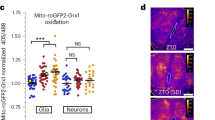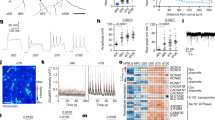Abstract
Sleep is controlled by two processes: a homeostatic drive that increases during waking and dissipates during sleep, and a circadian pacemaker that controls its timing1. Although these two systems can operate independently2,3, recent studies indicate a more intimate relationship4,5. To study the interaction between homeostatic and circadian processes in Drosophila, we examined homeostasis in the canonical loss-of-function clock mutants period (per01), timeless (tim01), clock (Clkjrk) and cycle (cyc01)6,7,8,9. cyc01 mutants showed a disproportionately large sleep rebound and died after 10 hours of sleep deprivation, although they were more resistant than other clock mutants to various stressors. Unlike other clock mutants, cyc01 flies showed a reduced expression of heat-shock genes after sleep loss. However, activating heat-shock genes before sleep deprivation rescued cyc01 flies from its lethal effects. Consistent with the protective effect of heat-shock genes, was the observation that flies carrying a mutation for the heat-shock protein Hsp83 (Hsp8308445)10 showed exaggerated homeostatic response and died after sleep deprivation. These data represent the first step in identifying the molecular mechanisms that constitute the sleep homeostat.
This is a preview of subscription content, access via your institution
Access options
Subscribe to this journal
Receive 51 print issues and online access
$199.00 per year
only $3.90 per issue
Buy this article
- Purchase on Springer Link
- Instant access to full article PDF
Prices may be subject to local taxes which are calculated during checkout




Similar content being viewed by others
References
Borbely, A. A. & Achermann, P. Sleep homeostasis and models of sleep regulation. J. Biol. Rhythms 14, 557–568 (1999)
Mistlberger, R. E., Bergmann, B. M., Waldenar, W. & Rechtschaffen, A. Recovery sleep following sleep deprivation in intact and suprachiasmatic nuclei-lesioned rats. Sleep 6, 217–233 (1983)
Tobler, I., Borbely, A. A. & Groos, G. The effect of sleep deprivation on sleep in rats with suprachiasmatic lesions. Neurosci. Lett. 42, 49–54 (1983)
Naylor, E. et al. The circadian clock mutation alters sleep homeostasis in the mouse. J. Neurosci. 20, 8138–8143 (2000)
Antle, M. C. & Mistlberger, R. E. Circadian clock resetting by sleep deprivation without exercise in the Syrian hamster. J. Neurosci. 20, 9326–9332 (2000)
Konopka, R. & Benzer, S. Clock mutants of Drosophila melanogaster. Proc. Natl Acad. Sci. USA 68, 2112–2116 (1971)
Sehgal, A., Price, J. L., Man, B. & Young, M. W. Loss of circadian behavioural rhythms and per RNA oscillations in the Drosophila mutant timeless. Science 263, 1603–1606 (1994)
Allada, R., White, N. E., So, W. V., Hall, J. C. & Rosbash, M. A mutant Drosophila homolog of mammalian Clock disrupts circadian rhythms and transcription of period and timeless. Cell 93, 791–804 (1998)
Rutila, J. E. et al. CYCLE is a second bHLH-PAS clock protein essential for circadian rhythmicity and transcription of Drosophila period and timeless. Cell 93, 805–814 (1998)
Castrillon, D. H. et al. Toward a molecular genetic analysis of spermatogenesis in Drosophila melanogaster: characterization of male-sterile mutants generated by single P element mutagenesis. Genetics 135, 489–505 (1993)
Shaw, P. J., Cirelli, C., Greenspan, R. J. & Tononi, G. Correlates of sleep and waking in Drosophila melanogaster. Science 287, 1834–1837 (2000)
Hendricks, J. C. et al. Rest in Drosophila is a sleep-like state. Neuron 25, 129–138 (2000)
Edgar, D. M., Dement, W. C. & Fuller, C. A. Effect of SCN lesions on sleep in squirrel monkeys: Evidence for opponent processes in sleep–wake regulation. J. Neurosci. 13, 1065–1079 (1993)
Dijk, D. J. & Czeisler, C. A. Paradoxical timing of the circadian rhythm of sleep propensity serves to consolidate sleep and wakefulness in humans. Neurosci. Lett. 166, 63–68 (1994)
Homyk, T., Szidonya, J. & Suzuki, D. T. Behavioral mutants of Drosophila melanogaster. Mol. Gen. Genet. 177, 553–565 (1980)
Armitage, R., Smith, C., Thompson, S. & Hoffman, R. Sex differences in slow-wave activity in response to sleep deprivation. Sleep Res. Online 4, 33–41 (2001)
Rechtschaffen, A., Gilliland, M. A., Bergmann, B. M. & Winter, J. B. Physiological correlates of prolonged sleep deprivation in rats. Science 221, 182–184 (1983)
Sapolsky, R. M. Stress hormones: good and bad. Neurobiol. Dis. 7, 540–542 (2000)
Ashburner, M. Patterns of puffing activity in the salivary gland chromosomes of Drosophila. Chromosoma 31, 356–376 (1970)
Marchler, G. & Wu, C. Modulation of Drosophila heat shock transcription factor activity by the molecular chaperone DROJ1. EMBO J. 20, 499–509 (2001)
Ornelles, D. A. & Penman, S. Prompt heat-shock and heat-shifted proteins associated with the nuclear matrix–intermediate filament scaffold in Drosophila melanogaster cells. J. Cell Sci. 95, 393–404 (1990)
Cirelli, C. & Tononi, G. Gene expression in the brain across the sleep–waking cycle. Brain Res. 885, 303–321 (2000)
Yoshida, E. N., Benkel, B. F., Fong, Y. & Hickey, D. A. Sequence and phylogenetic analysis of the SNF4/AMPK gamma subunit gene from Drosophila melanogaster. Genome 42, 1077–1087 (1999)
Ma, E. & Haddad, G. G. Isolation and characterization of the hypoxia-inducible factor 1β in Drosophila melanogaster. Brain Res. Mol. Brain Res. 73, 11–16 (1999)
Cornelius, G. & Engel, M. Stress causes induction of MAP kinase-specific phosphatase and rapid repression of MAP kinase activity in Drosophila. Cell Signal. 7, 611–615 (1995)
Ekengren, S. et al. A humoral stress response in Drosophila. Curr. Biol. 11, 714–718 (2001)
Perezgasga, L., Segovia, L. & Zurita, M. Molecular characterization of the 5′ control region and of two lethal alleles affecting the hsp60 gene in Drosophila melanogaster. FEBS Lett. 456, 269–273 (1999)
Hogenesch, J. B. et al. Characterization of a subset of the basic-helix–loop–helix-PAS superfamily that interacts with components of the dioxin signalling pathway. J. Biol. Chem. 272, 8581–8593 (1997)
Rechtschaffen, A. Current perspectives on the function of sleep. Perspect. Biol. Med. 41, 359–390 (1998)
Rechtschaffen, A., Bergmann, B. M., Everson, C. A., Kushida, C. A. & Gilliland, M. A. Sleep deprivation in the rat: X. Integration and discussion of the findings. Sleep 12, 68–87 (1989)
Acknowledgements
We thank H. Dierick, R. Andretic and K. Long for helpful comments on the manuscript, and J. Hendricks for sharing data before publication. This work was performed at The Neurosciences Institute, which is supported by the Neurosciences Research Foundation.
Author information
Authors and Affiliations
Ethics declarations
Competing interests
The authors declare that they have no competing financial interests.
Supplementary information
Rights and permissions
About this article
Cite this article
Shaw, P., Tononi, G., Greenspan, R. et al. Stress response genes protect against lethal effects of sleep deprivation in Drosophila. Nature 417, 287–291 (2002). https://doi.org/10.1038/417287a
Received:
Accepted:
Issue Date:
DOI: https://doi.org/10.1038/417287a
This article is cited by
-
Multisite regulation integrates multimodal context in sensory circuits to control persistent behavioral states in C. elegans
Nature Communications (2023)
-
Peculiar sleep features in sympatric species may contribute to the temporal segregation
Journal of Comparative Physiology B (2023)
-
Sleep insufficiency, circadian rhythms, and metabolomics: the connection between metabolic and sleep disorders
Sleep and Breathing (2023)
-
Association between sleep habits and behavioral problems in early adolescence: a descriptive study
BMC Psychology (2022)
-
Estimation of gingival crevicular fluid oxidative stress markers in school-aged children and teenagers with insufficient sleep
BMC Oral Health (2022)
Comments
By submitting a comment you agree to abide by our Terms and Community Guidelines. If you find something abusive or that does not comply with our terms or guidelines please flag it as inappropriate.



